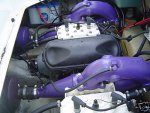Re: Cheaper 2 Stroke Oil?
This info relates to APV valved 2 stroke engines only- you most commonly see them today in personal watercraft and snowmobiles. Oil selection is critical to keep them clean and operating properly.
Variable exhaust power valves are moving devices located at the engine's exhaust port. Every brand's variation is there to provide the same essential service and that is to vary the height and width of the exhaust port according to engine RPM. This vastly broadens the power band. At low RPM, the valves are in a closed position which promotes more complete combustion. This improves low-end torque and minimizes unburned gases in the exhaust stream. At high RPM, the valves are wide open which allows for optimum exhaust flow. This enables the engine to rev freely and produce maximum top end horsepower. Older systems were actuated by a mechanical linkage which opened and closed the valves based on engine RPM. Modern systems are actuated by electronic servo motors which precisely position the valves throughout the RPM range. Before the advent of the power valve, engine builders had to determine one size and shape of the exhaust port and exhaust pipe. This predetermined whether the engine would provide its optimum power delivery at either the high, mid or low RPM range. The power valve allows the two-cycle engine to provide usable horsepower throughout its operating RPM range.
The modern power valve system has evolved from a number of different variations over the last 30 years. Yamaha was the first company to find success with this concept when they integrated a variable exhaust power valve system in their 2-stroke Grand Prix road-racing motorcycles in the late 1970's. The technology then made its way to Yamaha's production road and motocross bikes the early 1980's. Other motorcycle manufacturers soon came up with their own systems. By the early 1990's, virtually all high-performance two-cycle motorcycles, ATV's, personal water-crafts and snowmobiles were equipped with variable exhaust power valve systems.
Keeping the power valve system clean is of paramount importance. As power valves are located directly in the stream of the exhaust flow, carbon deposits can accumulate on the valves over time. The deposit build-up can alter the shape of the valves and change the engine's exhaust flow characteristics. In extreme cases, the exhaust port can become completely clogged and expensive damage can occur. Deposits can also can hinder the valve movement or leave them stuck in one spot. Any of these scenarios will drastically impair the power delivery and output of your engine.
A major contributor to power valve depositing is the use of poor quality 2-cycle oil. The cheaper base stocks and additives used in lower grade oils can be cooked into carbon deposits very quickly. High quality synthetic two-cycle oil is notorious for its clean burning characteristics and will dramatically lower the rate of deposit formation. Good quality synthetic oils use sophisticated base stocks and high temperature additives which are engineered to avoid power valve depositing. They also have an effective detergent/dispersant package which will allow for much cleaner operation. When it comes to two-stroke injector oil, you definitely get what you pay for. Spending a little more on an oil that is specifically engineered to provide clean power valve operation will not only improve the engine's performance, it will save the headaches and expense that come with premature power valve depositing.
Power valves truely maximize the capabilities of 2 stroke engines in certain applications (PWC, snowmobiles, etc)- oil quality in those engines is an important part of the performance equation.




















